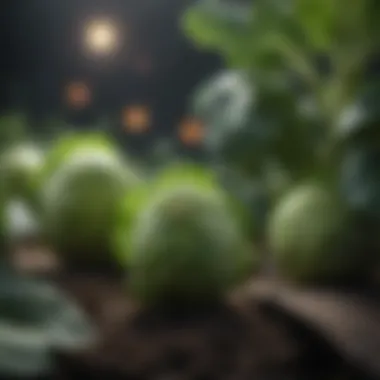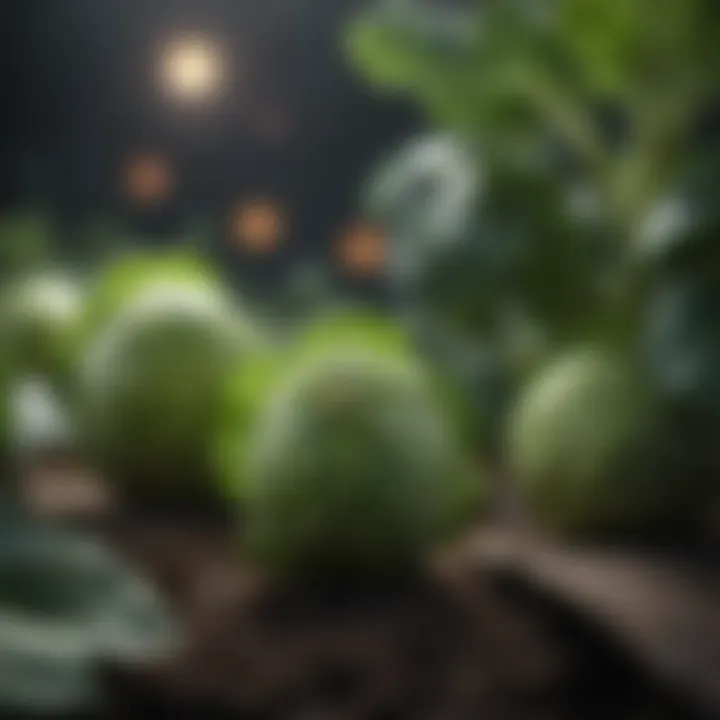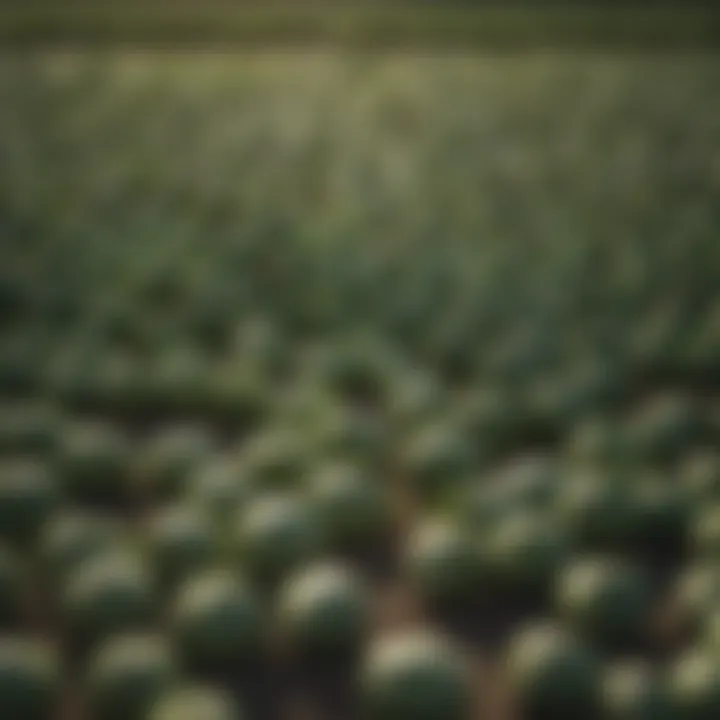Exploring Rubine Brussels Sprouts: Flavor and Benefits


Intro
Rubine Brussels sprouts provide an intriguing subject for examination in both agricultural science and culinary fields. This unique cultivar has gained attention for its vibrant color and distinct flavor profile, setting it apart from traditional green varieties. As a research focus, Rubine Brussels sprouts embody significant potential in food innovation and nutritional offerings. By exploring the biology, cultivation techniques, and market viability of this plant, we can uncover not only its benefits but also its relevance in a rapidly evolving food industry.
Background and Context
Overview of the Research Topic
Rubine Brussels sprouts, known for their deep maroon hues, are part of the Brassica oleracea species. Breeders selected this variety to provide a visually striking alternative to common Brussels sprouts. The plant’s appealing color is complemented by a flavor that is often described as nutty and slightly sweet. This cultivar has caught the attention of chefs and nutritionists alike, offering versatility in culinary applications.
Historical Significance
Historically, Brussels sprouts have their roots in Belgium, where they were cultivated as early as the 16th century. However, the introduction of the Rubine variety is a more recent innovation that aimed to enhance appeal both nutritionally and visually. The growing interest in organically cultivated produce has further fueled the demand for unique cultivars like Rubine, as consumers seek out sustainable and attractive food options.
Key Findings and Discussion
Major Results of the Study
Research indicates that Rubine Brussels sprouts contain higher levels of anthocyanins compared to traditional varieties. These compounds are known for their antioxidant properties. Additionally, educational studies with consumers show an increasing preference for visually appealing vegetables, driving the market interest for Rubine Brussels sprouts.
Detailed Analysis of Findings
- Nutritional Profile
- Cultivation Techniques
- Market Viability
- Rich in vitamins C and K
- Contains fiber and various minerals
- High in antioxidants due to anthocyanin content
- Grown under similar conditions as traditional Brussels sprouts
- Requires slightly different fertilization methods due to its unique needs
- Increasing demand in both grocery stores and specialty markets
- Appeal among chefs seeking unique ingredients for innovative dishes
"Rubine Brussels sprouts not only offer nutritional benefits but also serve as a visual and flavorful asset in culinary practices."
Prelude to Rubine Brussels Sprouts
The Rubine Brussels sprouts represent a noteworthy advancement in the cultivation of this popular vegetable. Understanding this unique cultivar is essential for various stakeholders, including researchers, growers, and culinary experts. Brussels sprouts are known for both their nutritional value and their distinct flavor. However, in the realm of agricultural science, the significance of particular cultivars like Rubine is often understated.
Exploration of this topic reveals not only the versatility of Brussels sprouts but also highlights how genetic traits can enhance their market appeal. The Rubine variety stands out due to its vibrant coloration and unique taste, which are attributes that may cater to evolving consumer preferences in modern agricultural practice. Additionally, raising awareness of Rubine Brussels sprouts can influence cultivation practices, production methods, and ultimately, market strategies.
Background of Brussels Sprouts
Brussels sprouts are a member of the Brassica family, which also includes cabbage and kale. They were cultivated in Belgium in the 16th century, thus the name Brussels sprouts. Due to their nutritional profile, they quickly gained popularity across Europe and eventually in other parts of the world. They contain essential vitamins, minerals, and a high content of dietary fiber, making them a favored choice among health-conscious individuals.
Historically, Brussels sprouts have faced challenges in cultivation, involving susceptibility to pests and preference for specific climates. Over time, various cultivars have been developed, leading to improvements in growth practices and better yield rates. This evolution has paved the way for innovative crops like Rubine to enter the market, each promising more than the traditional varieties.
What Makes Rubine Unique
Rubine Brussels sprouts distinguish themselves with their vibrant red and green hues. This coloration is not only visually appealing but also indicative of their rich anthocyanin content. Anthocyanins are natural compounds recognized for their antioxidant properties. This unique pigment is a significant reason behind Rubine's rising popularity.
The flavor profile of Rubine is another noteworthy aspect. It possesses a milder and sweeter taste compared to traditional green varieties, making it versatile for various culinary uses. Chefs and home cooks alike appreciate its ability to stand out in dishes while still complementing other flavors.
Lastly, Rubine Brussels sprouts have demonstrated resilience against common pests and diseases. This robustness enhances their market viability and appeals to sustainable farming practices. The potential for Rubine lies not only in its aesthetic and taste but also in its ability to thrive in changing agricultural conditions, contributing to a more diverse crop portfolio for growers.
Botanical Classification
Understanding the botanical classification of Rubine Brussels sprouts is essential for grasping its significance in agricultural and culinary contexts. Classification provides a systematic framework for categorizing plants, helping researchers, cultivators, and consumers alike to understand the relationships among various cultivars. In the case of Rubine Brussels sprouts, knowing its family and genus aids in recognizing its unique traits and potential agricultural benefits. Additionally, classification helps in identifying suitable growing conditions and management practices tailored to this specific variety.
Family and Genus
Rubine Brussels sprouts belong to the family Brassicaceae, which is commonly known as the cabbage or mustard family. This family includes a wide range of vegetables, such as cabbage, kale, and broccoli. The genus for Rubine Brussels sprouts is Brassica, which encompasses numerous edible species and cultivars.
This classification points to the shared characteristics of certainly these plants. For instance, the Brassica genus is known for its high nutritional value and resilience in diverse growing conditions. Rubine Brussels sprouts, with their vibrant color and distinct flavor, showcase traits that are appealing to both consumers and growers. By placing Rubine within this context, it highlights the importance of selecting cultivars that meet specific agricultural goals while catering to evolving consumer preferences.
Hybrid Characteristics
Rubine Brussels sprouts are a hybrid cultivar. This aspect of its classification reveals information about its genetic makeup and the breeding techniques used in its development. Hybrid plants are often bred to enhance desirable traits, such as yield, taste, and disease resistance.


One important characteristic of Rubine is its striking pigmentation. Its bright purple hue sets it apart from traditional green Brussels sprouts and speaks to the increasing consumer demand for visually appealing produce.
- Yield and Robustness: Hybrid varieties like Rubine are often cultivated for their higher yields compared to non-hybrid counterparts. They tend to exhibit more robust growth and better adaptability to varying climates.
- Nutritional Benefits: The hybridization process aims not only to enhance flavor and appearance but also to maintain or improve the nutritional profile of the crop. Rubine Brussels sprouts retain vital vitamins and minerals, contributing to their health benefits.
The hybrid nature of Rubine means that growers must be knowledgeable about proper cultivation techniques to maximize the benefits of these plants while addressing challenges such as diseases that may target hybrid varieties.
In summary, botanical classification serves as a critical foundation for comprehending the significance of Rubine Brussels sprouts in agriculture. By understanding its family and genus, along with its hybrid characteristics, one can appreciate the unique qualities of this cultivar.
Cultivation Practices
Cultivation practices are a crucial element in the overall success of Rubine Brussels sprouts. Understanding how to effectively grow this cultivar not only ensures higher quality produce but also maximizes yield. A well-planned cultivation strategy encompasses specific growing conditions, pest management strategies, and harvesting techniques. These factors contribute to both the sustainability and economic viability of growing Rubine Brussels sprouts.
Growing Conditions
For optimal growth, Rubine Brussels sprouts require specific conditions. They thrive in well-drained, fertile soil. The ideal pH level for soil is between 6.0 and 7.5. Adequate sunlight is essential, with these plants needing at least six hours of direct sunlight daily. Temperature plays a significant role too; they prefer cooler climates, ideally between 55°F and 75°F. Extreme temperatures can hinder growth and affect the taste of the sprouts. In addition, consistent moisture levels are paramount, as they help in developing the flavor without causing stress to the plant.
Pest Management Strategies
Effective pest management strategies are vital to protect Rubine Brussels sprouts from various threats. Common pests include aphids, cabbage worms, and flea beetles. Utilizing integrated pest management (IPM) techniques can mitigate the impact of these pests. This includes introducing beneficial insects like ladybugs, which can naturally control aphid populations, and using barriers such as row covers to protect young sprouts. Regular monitoring of plants for pest infestations aids in early detection and prevents larger issues. Additionally, organic pesticides can be employed if pest levels rise, ensuring the safety and quality of the final product.
Harvesting Techniques
Harvesting Rubine Brussels sprouts requires careful attention to timing and technique. It is essential to harvest when the sprouts are firm and have reached their optimal size, typically about 1 to 2 inches in diameter. The best time to harvest is after the first frost, as the cold enhances the flavor. Care should be taken to twist or cut the sprouts from the plant to minimize damage. A technique called "top harvesting" is often recommended. This involves removing the top of the plant first, which encourages the lower sprouts to mature more quickly.
Proper cultivation practices not only enhance the quality of Rubine Brussels sprouts but also significantly boost marketability and consumer satisfaction.
In summary, the cultivation practices for Rubine Brussels sprouts directly impact not just the growth, but also the economic success and sustainability of its farming. Understanding specific growing conditions, effective pest management, and employing correct harvesting techniques will yield the best results.
Nutritional Profile
The Nutritional Profile of Rubine Brussels sprouts is critical for understanding their role in promoting health and well-being. These sprouts are not just a vibrant addition to the plate; they also carry a range of essential nutrients that contribute to various bodily functions. By examining the vitamins, minerals, dietary fiber content, and health benefits, we can appreciate why Rubine Brussels sprouts occupy a valuable space in both culinary and health conversations.
Vitamins and Minerals
Rubine Brussels sprouts are rich in vital vitamins and minerals. Notably, they are an excellent source of Vitamin C and Vitamin K. Vitamin C plays a crucial role in supporting the immune system and acts as a powerful antioxidant, helping to combat oxidative stress. On the other hand, Vitamin K is essential for effective blood clotting and bone health.
The mineral content of Rubine Brussels sprouts includes:
- Folate: Important for DNA synthesis and repair.
- Potassium: Aids in maintaining healthy blood pressure levels.
- Iron: Key for oxygen transport in the body.
Each serving of Rubine Brussels sprouts provides a substantial amount of these vitamins and minerals, which are vital for overall health. Their nutrient density makes them a worthy addition to a balanced diet.
Dietary Fiber Content
Another significant aspect of the nutritional profile is their dietary fiber content. Rubine Brussels sprouts contain both soluble and insoluble fiber. This dual fiber composition contributes to digestive health by promoting regular bowel movements and supporting gut microbiota.
Beneficial effects of dietary fiber include:
- Lowering cholesterol levels.
- Regulating blood sugar levels, which can prevent spikes and crashes.
- Enhancing feelings of fullness, potentially aiding weight management endeavors.
Including Rubine Brussels sprouts in meals can facilitate a lifestyle that prioritizes digestive health and nutrient absorption.
Health Benefits
The health benefits of Rubine Brussels sprouts extend well beyond mere nutrients. Regular consumption can lead to several positive health outcomes, such as:
- Reduced risk of chronic diseases like heart disease and diabetes due to the high antioxidant capacity.
- Support for weight management through lower caloric density and high nutrient content.
- Improved bone health given their Vitamin K and calcium content.
Furthermore, scientific studies indicate that cruciferous vegetables, including Brussels sprouts, may have anti-inflammatory properties. This suggests a potential protective role against certain cancers and other inflammatory disorders.
"Incorporating Rubine Brussels sprouts into one's diet is not merely a trend; it aligns with nutritional science advocating for increased vegetable intake due to their myriad health benefits."
In summary, the Nutritional Profile of Rubine Brussels sprouts reveals an impressive array of vitamins and minerals, substantial dietary fiber, and significant health benefits. Each of these elements underscores the importance of this unique cultivar in promoting optimal health.
Culinary Uses


The culinary applications of Rubine Brussels sprouts are varied and significant, showcasing their versatility in modern cuisine. Understanding how to utilize this unique cultivar is paramount for chefs and home cooks alike. The vibrant color and distinct flavor add aesthetic and taste value to a wide range of dishes.
Flavor Profile Analysis
Rubine Brussels sprouts possess a notable flavor that sets them apart from standard varieties. Their flavor profile combines a nutty, slightly sweet taste with a hint of earthiness. This quality enhances their role in diverse recipes. The robust flavor allows them to stand alone as a side dish or to complement various main courses.
Often prepared with simple seasonings, like olive oil and sea salt, Rubine Brussels sprouts can also handle bold flavors. Ingredients like garlic, lemon zest, or balsamic vinegar can elevate their taste further. To maintain their unique flavor, gentle cooking methods like roasting or steaming are recommended. Overcooking might lead to a loss of essential flavor characteristics.
Preparation Methods
Preparing Rubine Brussels sprouts is straightforward yet requires attention to detail. Here are some common methods:
- Roasting: Roasting these sprouts enhances their natural sugars, imparting a caramelized flavor. Preheat the oven to 400°F (200°C), coat the sprouts with olive oil, and arrange them in a single layer. Roast for about 25-30 minutes or until they are tender and browned.
- Steaming: Steaming preserves the nutritional content while providing a tender texture. Place the sprouts in a steamer basket over boiling water for about 6-8 minutes.
- Sautéing: For a quicker option, sautéing in a skillet requires only a few minutes. Use medium heat and add minced garlic for additional flavor.
- Blanching: Blanching can help prepare Brussels sprouts for freezing or as a base for salads. Briefly immerse them in boiling water, then transfer to ice water to halt the cooking process.
These methods preserve the flavor and dietary benefits of Rubine Brussels sprouts effectively.
Recipe Examples
Incorporating Rubine Brussels sprouts into meals is simple. Here are a few recipe examples:
- Roasted Rubine Brussels Sprouts: Toss sprouted halves with olive oil, salt, and pepper. Roast until golden. Finish with a splash of balsamic vinegar.
- Sautéed Sprouts with Garlic: Sauté diced shallots and minced garlic in olive oil. Add halved Rubine sprouts and cook until just tender. Season with salt and black pepper.
- Brussels Sprouts Salad: Shred raw Rubine sprouts, then mix them with sliced apples, nuts, and a vinaigrette dressing. This salad is refreshing and packed with nutrients.
These dishes highlight the adaptability of Rubine Brussels sprouts, making them an attractive addition to any culinary repertoire.
Integrating Rubine Brussels sprouts into a diet not only enhances flavor but also introduces various nutritional benefits. They serve as an excellent source of vitamins and minerals, aligning well with health-conscious meal planning.
Market Trends
Understanding market trends related to Rubine Brussels sprouts offers valuable insights into their cultivation and consumption. These trends influence both agricultural practices and consumer choices. As the popularity of unique and nutritious vegetables expands, analyzing these trends becomes essential for growers, marketers, and consumers alike.
Demand in Fresh Produce Markets
The demand for Rubine Brussels sprouts in fresh produce markets has been steadily increasing. Consumers are becoming more health-conscious and are seeking vegetables with higher nutritional value. Rubine Brussels sprouts, with their vibrant color and unique taste, attract attention on grocery shelves. This not only raises their marketability but also contributes to their growing demand.
Some key factors influencing this demand include:
- Health Trends: An increased focus on plant-based diets has led to a rise in the consumption of Brussels sprouts.
- Culinary Popularity: Social media and food blogs emphasize creative recipes featuring these sprouts, driving consumer interest.
- Sustainability: Many consumers prefer locally sourced produce, positioning Rubine Brussels sprouts favorably in local markets.
Economic Viability for Growers
From an economic perspective, Rubine Brussels sprouts present a viable option for growers. They can attract higher prices due to their specialty status. Growers investing in Rubine may benefit from premium pricing, especially during off-peak seasons. Moreover, sustainable cultivation practices can lower costs in the long run.
Some economic factors to consider include:
- Market Pricing: Specialty crops command higher prices, increasing profitability.
- Production Costs: Understanding the cost of cultivation and management is crucial for profitability.
- Risk Management: Diversifying crops with unique varieties like Rubine can mitigate risks associated with market fluctuations.
Consumer Awareness and Preferences
Consumer awareness regarding Rubine Brussels sprouts is growing, aided by increased visibility in retail settings and online platforms. Today's consumers actively seek out information about the foods they eat, including origin, nutritional benefits, and preparation methods. This trend makes it necessary to effectively communicate the unique qualities of Rubine Brussels sprouts.
Key aspects of consumer preferences include:
- Education: Providing information about the origins and benefits of Rubine is essential to attract health-conscious consumers.
- Taste Tests and Demos: In-store tastings can significantly enhance consumer interest.
- Engagement on Social Media: Platforms like Reddit and Facebook allow growers to connect with consumers and share recipes, fostering a community around this vegetable.
Overall, understanding and adapting to market trends related to Rubine Brussels sprouts not only enhances their appeal but also supports economic growth for growers and increases consumer satisfaction.
Environmental Impact
The environmental impact of cultivating Rubine Brussels sprouts is a key aspect of this analysis. Understanding how this particular cultivar affects the ecosystem can provide insights for growers, consumers, and researchers alike.
Sustainability of Cultivation
Rubine Brussels sprouts offer a sustainable option in vegetable farming. These plants are resilient and require relatively low maintenance compared to other crops. This resilience can lead to reduced chemical input, meaning less reliance on synthetic fertilizers and pesticides.
- Soil Health: Their cultivation supports soil health due to crop rotation benefits. Brussels sprouts can help decrease soil erosion and enhance soil nutrient cycles.
- Water Usage: The species can adapt well to varying moisture conditions, which can lead to more efficient water management in agricultural practices.
- Environmental Footprint: As demand for sustainable produce grows, Rubine Brussels sprouts align well with this movement through their relatively low environmental footprint compared to more resource-intensive crops.


Biodiversity Considerations
Promoting biodiversity is crucial in modern agricultural practices. Rubine Brussels sprouts can contribute positively to this objective.
- Genetic Diversity: Diversifying crop choices such as Rubine can help maintain genetic variety within ecosystems. This is important in combating plant diseases and adapting to changing climate conditions.
- Habitat for Pollinators: Cultivating Rubine Brussels sprouts can provide a habitat for essential pollinators, which is vital for maintaining biodiversity within agricultural systems.
- Intercropping Benefits: These sprouts can be grown alongside other plants, promoting interactions that enhance symbiotic relationships in the soil and among plant species.
"Biodiversity is not just about conserving species; it is about ensuring ecosystem functions that benefit agriculture and our food supply."
Clinical Studies and Research
Research into clinical aspects of Rubine Brussels sprouts is crucial for understanding their role in nutrition and health. This section highlights the need for scientific inquiry into this unique cultivar, exploring nutritional efficacy and its overall impact on consumer health. Rigorous studies are essential for validating the benefits that Rubine Brussels sprouts are claimed to offer. They provide a foundation for recommendations that guide consumer choices and inform agricultural strategies.
Nutritional Efficacy Studies
Nutritional efficacy studies focus on validating the nutritional claims made about Rubine Brussels sprouts. These studies often assess the concentration of vitamins, minerals, and phytochemicals in the sprouts.
Research has shown that Rubine Brussels sprouts are rich in vitamins K and C, as well as dietary fiber. Clinical trials may vary, but they aim to dissect how these nutrients contribute to health outcomes. For instance:
- Vitamin K is essential for blood coagulation and bone metabolism.
- Vitamin C acts as an antioxidant, helping to protect cells from damage and supporting the immune system.
- Dietary fiber is known for its role in promoting digestive health and regulating cholesterol levels.
Such studies not only measure the quantity of these nutrients but also investigate their bioavailability and potential health benefits to consumers. For example, a randomized control trial might be conducted to assess changes in cholesterol levels among individuals who regularly consume Rubine Brussels sprouts. These results can significantly inform health professionals about the benefits of including this cultivar in a balanced diet.
Consumer Health Impact Analyses
Consumer health impact analyses examine how foods like Rubine Brussels sprouts can influence health behaviors and outcomes. These analyses often involve population studies or surveys that assess dietary patterns and their correlation to health metrics. The goal is to determine whether the incorporation of Rubine Brussels sprouts into a regular diet can lead to measurable health benefits.
Key factors considered in these analyses include:
- Health outcomes, such as reduced incidence of chronic diseases.
- Consumer awareness regarding the health benefits of Brussels sprouts.
- Psychological aspects, including motivation for choosing healthy foods.
In one case, research may show that consumers who are educated about the benefits of Rubine Brussels sprouts are more likely to incorporate them into their meals, leading to improved dietary habits. Understanding this relationship is vital for nutrition advocates aiming to promote healthier eating patterns. Studies like these can lead to recommendations that can directly influence public health policy.
"Understanding the nutritional efficacy of Rubine Brussels sprouts through clinical studies can bridge the gap between agricultural innovation and consumer health advocacy."
Future Prospects
The future of Rubine Brussels sprouts appears promising, underscored by recent innovations in agricultural practices and shifting consumer demands. This section delves into two critical areas: advancements in breeding techniques and evolving consumer preferences. Understanding these elements is essential for growers and marketers aiming to optimize production and maximize market potential.
Innovations in Breeding
Innovations in breeding techniques play a pivotal role in enhancing the characteristics of Rubine Brussels sprouts. Recent advancements include genomic selection and marker-assisted breeding. These methods allow for more precise selection of traits, such as disease resistance and improved flavor profiles. Researchers are increasingly focusing on the importance of flavor and texture in Brussels sprouts, benefiting from Rubine's unique genetic makeup.
In addition to flavor, breeders are also exploring factors such as yield efficiency and environmental adaptability. By developing strains that are more resilient to climate fluctuations, growers can reduce risks associated with adverse weather. This is especially important given the unpredictable nature of climate change, which poses a threat to traditional farming practices. Improved varieties may lead to better survival rates, thus ensuring a more stable supply in the markets.
Moreover, public interest in organic and sustainable farming practices fuels the urge for breeding innovations. Plants that require fewer chemical treatments not only appeal to environmentally-conscious consumers but also enhance the overall reputation of Brussels sprouts as a healthy option. As these innovations continue to evolve, Rubine Brussels sprouts may set a benchmark for future cultivars, solidifying their place in the produce section.
Consumer Trends and Adaptations
Consumer trends are shifting, heavily influencing agricultural markets. A growing focus on health and wellness has directed attention towards nutrient-rich foods. Rubine Brussels sprouts are well-positioned to capitalize on this trend, thanks to their robust nutritional profile, including high vitamin content and fiber. As functional foods gain traction among health-conscious individuals, the demand for these sprouts could increase substantially.
Additionally, modern consumers are more informed about the origin of their food. Transparency in sourcing and sustainability practices plays a crucial role in purchasing decisions. Thus, growers of Rubine Brussels sprouts need to highlight their farming methods, ensuring that they resonate with consumer values. By providing clear information about cultivation methods, certifications, and health benefits, producers can engage more effectively with their target market.
Moreover, culinary versatility is becoming increasingly relevant. As home cooking continues to rise, recipes using Rubine Brussels sprouts can appeal to this trend. Creating easily shareable content, like visual recipe guides, may foster a community around the product. This also presents a unique opportunity to showcase Rubine's distinctive color and flavor.
"Adapting to consumer preferences will be critical for the future success of Rubine Brussels sprouts in a competitive market."
In summary, the future prospects for Rubine Brussels sprouts hold significant potential. Innovations in breeding offer tools to enhance resilience and flavor, while understanding consumer trends ensures that growers can meet market demands. Awareness of these dynamics can drive both production and consumption, establishing Rubine Brussels sprouts as an essential player in the fresh produce market.
Ending
The conclusions drawn from this comprehensive analysis of Rubine Brussels sprouts hold significant weight in understanding their role in modern agriculture and nutrition. Analyzing this unique cultivar reveals not only its exceptional qualities but also its broader implications in food production and consumer preferences.
Summary of Key Findings
In summary, Rubine Brussels sprouts stand out due to their vibrant color, rich flavor, and exceptional nutritional profile. Their cultivation practices involve specific conditions that ensure quality growth, and they exhibit resilience against common pests. Nutritionally, they provide essential vitamins, minerals, and dietary fiber, making them an invaluable addition to diets. In the culinary realm, they offer versatility, capable of enhancing a range of dishes. Market trends indicate a growing demand for unique produce like Rubine, driven by consumer awareness and shifts in eating habits.
"Unique cultivars like Rubine Brussels sprouts are paving the way for sustainable agriculture and healthier eating choices."
Implications for Future Research
Future research should examine the impact of Rubine Brussels sprouts on both agricultural practices and consumer health. Areas for further study include the exploration of innovative breeding techniques that can enhance drought resistance and nutritional content without sacrificing flavor. Potential studies can also assess the environmental benefits of cultivating Rubine compared to traditional varieties.
Additionally, investigating consumer perceptions and marketing strategies could improve the understanding of how to promote these sprouts effectively. Insights from such studies can help growers adapt to changing market demands and ultimately contribute to sustainable food systems.





